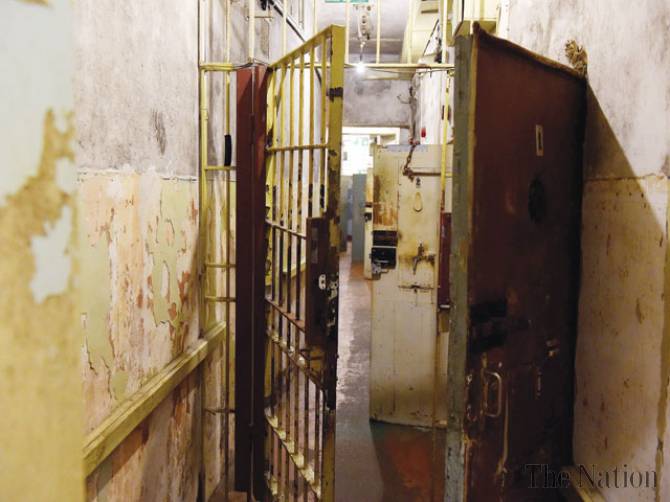|
Latvia’s former KGB headquarters gives up its secrets
Other News 
 Cell doors are seen behind a lattice door in the basement of the KGB headquarters. Source: AFP THE “House on the Corner” was one of the most feared places in Latvia during Soviet times, but now tourists are flocking to the former KGB headquarters in the capital, Riga, keen to uncover its dark secrets. As Russia flexes its muscles in its communist-era backyard, there is a concerted drive here and in other Baltic States once under Soviet control to counter any attempts by Moscow to whitewash the totalitarian past by exposing its horrors. Built in 1912, the vast property retains traces of its Art Nouveau elegance, but a grimy, weathered exterior lends it an eerie air. Following the 1940 Soviet takeover, the KGB secret police, or Cheka, set up its headquarters in the building on what is now Freedom Street, but was then called Lenin Street. It was then that locals started referring to the building using the euphemism “the House on the Corner”. Shuttered as the KGB was disbanded after Latvia broke free from the crumbling Soviet Union in 1991, it finally reopened its doors to the public this summer with a temporary exhibition as part of Riga’s year as a European Capital of Culture. In a dark hallway, visitors to the house are greeted by a wooden box where paper requests for information about prisoners and denunciations of neighbours and work colleagues were once deposited. A ground-floor exhibition details KGB crimes, while in the basement, cells that once held prisoners have after many years finally been opened to the public. “The main reaction we get is shock,” Aija Abens, one of the guides, told AFP.
 Guide Aija Abens stands in the courtyard of building. Source: AFP
“Some people come, then decide not to set foot inside. Some people break down in tears. That’s when we realise that they or their relatives must have been held here.” Thousands of Latvians were interrogated and tortured in the building, some of them put to death behind its walls, and Abens is visibly moved as she describes the former execution chamber. “It’s right by the door to the yard. A truck would be parked outside with the motor running to mask the noise. Then the body would be put in the back and driven away,” she says. Later the KGB began killing their victims elsewhere, so they converted the execution cell into a kiosk where agents could stock up on cigarettes. “We get visitors from Russia who think it’s all made up, but we also get Russian visitors who say it has opened their eyes,” Abens told AFP.
 It was one of the most feared places in Latvia during Soviet times. Source: AFP
They have even had some visitors who, she believes, once worked here. “We showed the KGB staff canteen on one tour and a visitor said: ‘Yes, but the food was good’. How could you know that unless you were part of the staff?” A couple of floors above, the atmosphere is very different. The corridors have been freshly painted a dazzlingly white and art installations invite visitors to consider abstract concepts of state power and totalitarianism. Several focus on the 60,000 Latvians who were deported to Siberia on the orders of Stalin, most in 1941 and 1947, and many of whom never returned.
 Flowers lie on a flap of a cell in the basement. Source: AFP
One piece, titled Latvian Suitcase, is among the most powerful. It highlights a question those exiled were forced to consider: what would you take if the KGB gave you two minutes to pack? Suitcases, letters, lucky charms, teddy bears, even a parcel of sand from a spouse’s grave are strewn around a large room. All the objects on show are original, each item once packed in haste by people who later found their way back home against the odds. Another installation uses a pair of men’s German army boots to explore the extraordinary life of Merija Grinberga, a woman from a renowned Latvian high society family who exchanged her high heels for heavy boots in 1944 to rescue items from the national museum slated for destruction by the Soviet Red Army. Studying one of the artworks is tourist Melanie Carter, from Florida.
 People are flocking to the former KGB headquarters. Source: AFP
“Until I arrived in Latvia I knew very little about the history. I’m impressed by the effort, imagination and creativity that has gone into this,” she said. “It’s an extraordinary project, given the building was used for such a horrifying purpose.” And it is this blood-soaked past that is proving to be major headache for public officials trying to find a future use for the “House on the Corner” — nobody wants to move into this otherwise prime, city-centre location. “Its dramatic history makes it unattractive. Probably offices are best suited to it,” says Baiba Strautmane, who manages the building for the State Property Agency. “There have been rumours of hotels, but that’s unlikely.” Pressure is growing for the building to be converted into a permanent museum, despite the fact Latvia already has a large centre — the Museum of the Occupation — focused on Soviet crimes. Knuts Skujenieks, a writer and former political prisoner who was once held here accused of “anti-Soviet” activity, is among those who support the museum idea.
 A corridor leading to cells. Source: AFP
“It’s true the building’s reputation isn’t very good, but I believe the city needs it so it remembers,” he said. “You can’t escape history. I can’t remember where everything was, but I want to see the cell where I was held.” Other News Related Content 7 Ways to Promote Your YouTube Channel If you have decided to create a YouTube channel, you need to find the best ways to promote it. After all, if it is not being promoted, people aren’t going to know about it, and you will be simply wasting your time because you won’t be making any money. The real reason why teenagers smoke is not addiction, it’s weight loss Shunning popular beliefs that people smoke cigarettes because they’re addicted to the nicotine, a recent study shows that among teens who are frequent smokers, 46% of girls and 30%of boys smoke to control their weight. Ramos MOS1 Max – When You’re Big, You Got to be Tough, Too With its name alone, you will know right away that this is one big smartphone and it is exactly that, with its screen measuring 6.44 inches. With its built in battery, you can expect that this can easily support your use for more than a day. But, is size everything there is to Ramos MOS1 Max or do you still have something to look out for in this particular handset? HOW TO BUILD MUSCLE AND STRENGTH WITHOUT LIFTING WEIGHTS Give yourself a break from all the heavy lifting and reap the muscle-building benefits of bodyweight exercise. How to Relieve Stress Through Music Did you know there are simple, easy ways to tackle your stress – without spending a fortune? One of the best ways to relieve stress is through music; and we’ve got the science to back it up. |
542





